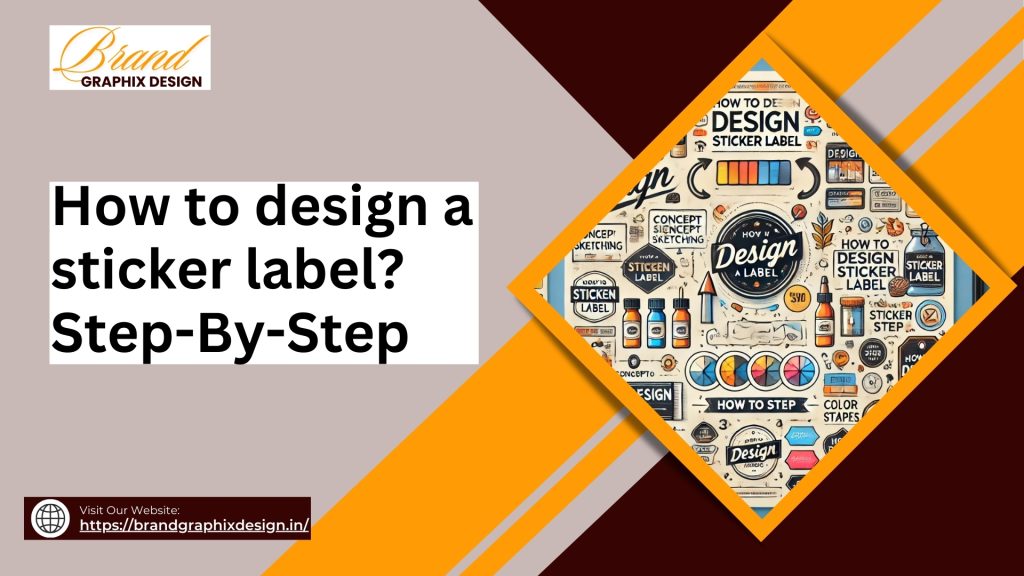Sticker labels are a versatile and cost-effective way to brand products, convey important information, and enhance the visual appeal of your items. Whether you’re labeling jars, bottles, boxes, or promotional items, a well-designed sticker label can make a significant impact. But how do you create a sticker label that not only looks great but also serves its purpose effectively? In this blog, we will take you through a step-by-step guide on how to design a sticker label that stands out and delivers results.
Step 1: Define the Purpose of Your Sticker Label
The first step in designing a sticker label is to clearly define its purpose. Understanding what you want the label to achieve will guide your design decisions and help you create a label that meets your goals.
- Identify the Label’s Function: Is the sticker label for branding, providing product information, or adding decorative elements? Knowing the primary function will help you prioritize design elements.
- Consider the Target Audience: Who will see and interact with this label? Your design should appeal to your target audience, whether they are children, adults, or a specific demographic group.
- Determine the Placement: Where will the sticker label be applied? The placement can affect the size, shape, and durability requirements of the label.
Defining the purpose of your sticker label from the start ensures that your design is focused and effective, helping you achieve your intended outcome.
Step 2: Choose the Right Size and Shape
The size and shape of your sticker label are crucial for both aesthetic appeal and functionality. The label should fit well on the product and complement its shape, while also being large enough to include all necessary information.
- Measure the Application Surface: Before deciding on the size, measure the surface where the sticker will be applied. Ensure that the label is neither too large nor too small for the product.
- Select a Shape: While rectangles and circles are common choices, consider custom shapes that align with your brand identity or product. Unique shapes can make your label more eye-catching.
- Ensure Usability: The label should be easy to apply without wrinkling or tearing. The shape should also not interfere with the usability of the product.
Choosing the right size and shape ensures that your sticker label looks good and functions well, making it easier for customers to engage with your product.
Step 3: Pick a Color Scheme
Color is a powerful tool in sticker label design. It can attract attention, convey emotions, and reinforce your brand identity. Selecting the right color scheme is essential for creating a label that stands out.
- Use Brand Colors: Incorporate your brand’s primary and secondary colors to maintain consistency across your products. This helps in building brand recognition.
- Consider the Product Color: Choose colors that complement the product’s color. For example, if your product is in a dark bottle, use lighter colors on the label for contrast.
- Ensure Readability: Make sure that the text and key elements stand out against the background. High contrast between text and background colors improves readability.
Picking a color scheme that aligns with your brand and enhances the product’s appearance can make your sticker label more effective in attracting customers.
Step 4: Select the Right Font
Typography plays a significant role in how your sticker label communicates with your audience. The fonts you choose should be easy to read and should match the tone of your brand.
- Prioritize Clarity: Choose fonts that are legible, even at smaller sizes. Sans-serif fonts are generally easier to read and work well for most products.
- Match Your Brand Style: The font should reflect your brand’s personality. For example, a playful, casual font might be suitable for a children’s product, while a sleek, modern font could work well for a tech product.
- Limit the Number of Fonts: Stick to one or two fonts to maintain a clean and professional look. Too many different fonts can make the label look cluttered and confusing.
The right font enhances readability and ensures that your sticker label effectively communicates its message to the customer.
Step 5: Create a Balanced Layout
The layout of your sticker label determines how the elements are arranged and how easy it is for customers to find the information they need. A well-balanced layout ensures that the label is both functional and aesthetically pleasing.
- Prioritize Key Information: Make sure that the most important information, such as the product name, key benefits, and branding, is prominently displayed.
- Use Visual Hierarchy: Guide the viewer’s eye through the label by using different font sizes, colors, and weights. This helps ensure that the most important elements are noticed first.
- Include White Space: Don’t overcrowd the label. Leave enough white space to separate different elements and make the label easier to read.
A balanced layout helps create a visually appealing sticker label that effectively communicates important information to the customer.
Step 6: Incorporate Imagery and Graphics
Images and graphics can add visual interest to your sticker label and help convey the product’s purpose or benefits. However, they should be used thoughtfully to avoid clutter and maintain clarity.
- Choose Relevant Images: Use images that are directly related to the product. For example, if you’re labeling a food product, consider using images of the ingredients or the final dish.
- Use High-Quality Graphics: Ensure that all images and graphics are high resolution. Low-quality images can make your label look unprofessional and reduce its impact.
- Incorporate Icons: Simple icons can quickly convey important information, such as certifications, usage instructions, or product features. Make sure they are clear and easy to understand.
Incorporating the right imagery and graphics can enhance the visual appeal of your sticker label and help communicate the product’s value more effectively.
Step 7: Highlight Important Information
Your sticker label should provide essential information that helps customers make informed purchasing decisions. It’s important to highlight this information clearly and prominently on the label.
- List Key Benefits: Highlight the primary benefits of the product, such as “organic,” “handmade,” or “sugar-free.” These should be easy to spot at a glance.
- Include Instructions: If the product requires specific usage instructions, make sure these are clearly written and easy to follow.
- Provide Legal Information: For food, cosmetics, or health products, include necessary legal information such as ingredients, nutritional facts, and any warnings.
Highlighting important information on your sticker label helps customers quickly understand the product’s benefits and make informed decisions.
Step 8: Choose the Right Material
The material of your sticker label affects both its appearance and durability. Choosing the right material ensures that the label not only looks good but also withstands the conditions it will be exposed to.
- Consider the Environment: Choose materials that are suitable for where the product will be used. For example, waterproof materials are ideal for products that will be exposed to moisture.
- Explore Different Finishes: Finishes like matte, gloss, or metallic can enhance the visual appeal of your label and give it a premium look and feel.
- Ensure Durability: The material should be durable enough to maintain its appearance over time, even with handling and exposure to various elements.
Choosing the right material for your sticker label ensures that it remains attractive and legible, enhancing the overall appeal of your product.
Step 9: Test Your Sticker Label Design
Before finalizing your sticker label design, it’s important to test it to ensure it meets all your requirements and will perform well in the market. Testing helps you identify any potential issues and make necessary adjustments.
- Get Feedback: Show your label design to a focus group or potential customers to gather feedback on its appeal, readability, and effectiveness.
- Test Durability: Assess the label’s durability by exposing it to conditions it will face, such as water, heat, or sunlight. Ensure it maintains its quality and appearance.
- Check Print Quality: Review the final printed label to ensure that the colors, text, and images match your design specifications and look as intended.
Testing your sticker label design ensures that it not only looks good but also performs well in real-world conditions, leading to higher
customer satisfaction and better sales.
Start Designing Your Sticker Labels Today
Designing a sticker label involves a careful balance of creativity, practicality, and attention to detail. By following these step-by-step guidelines, you can create a sticker label that not only enhances your product’s appeal but also effectively communicates its value to your customers. If you need professional help in designing your sticker labels, we’re here to assist you. Contact us today at +91 91189 11171 to start creating labels that make your products stand out.



